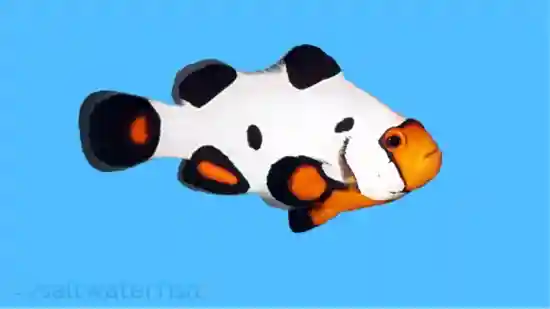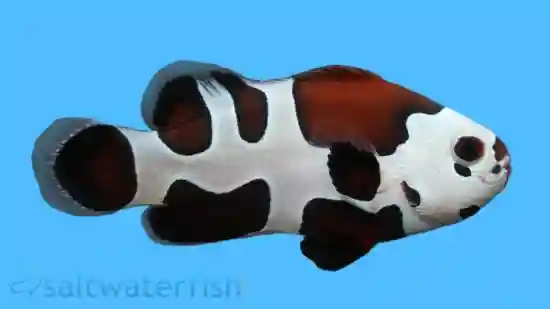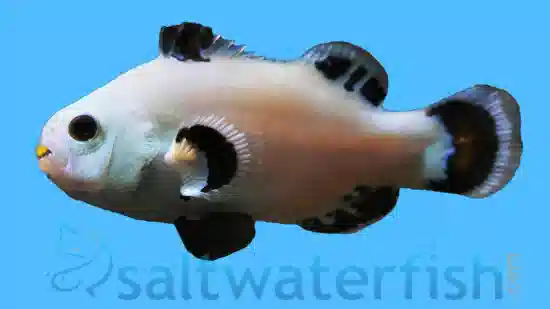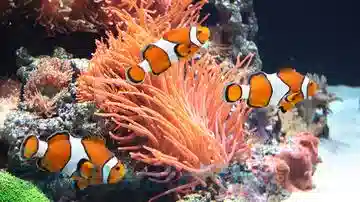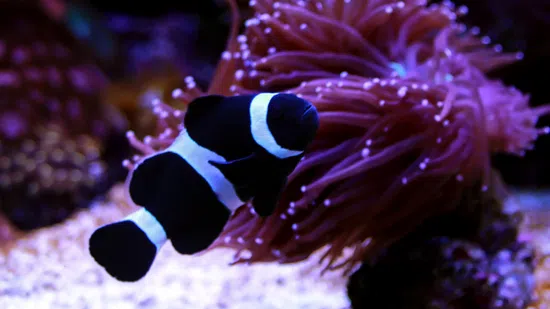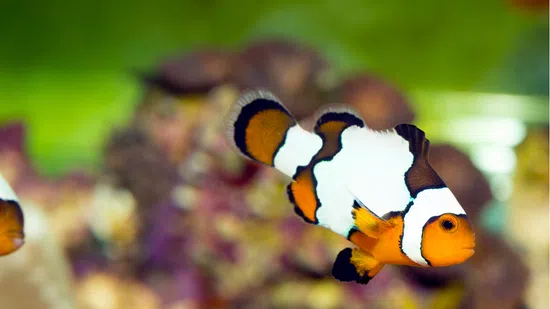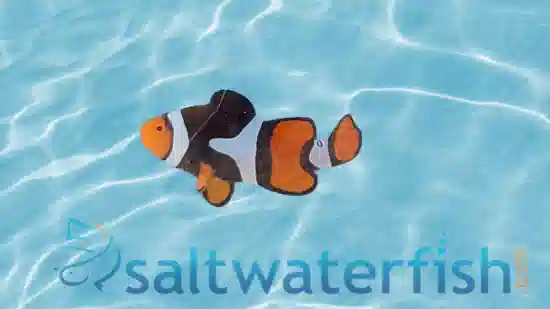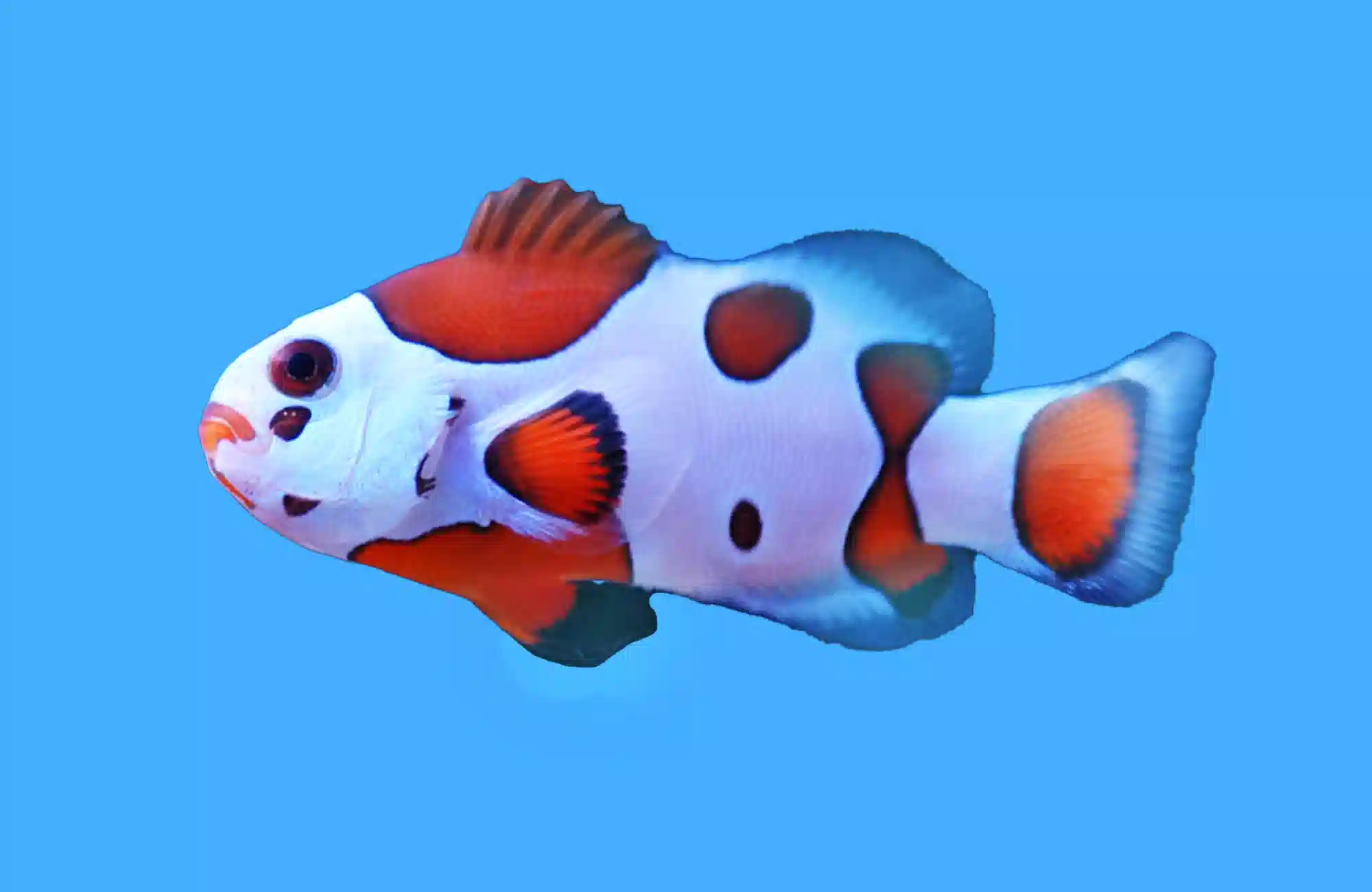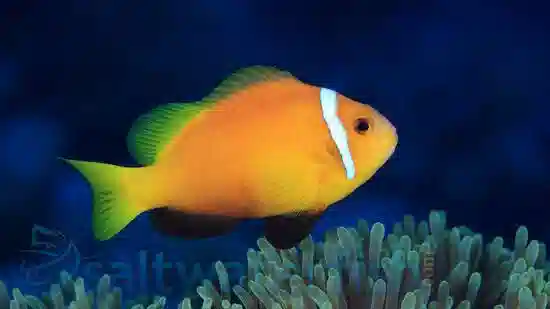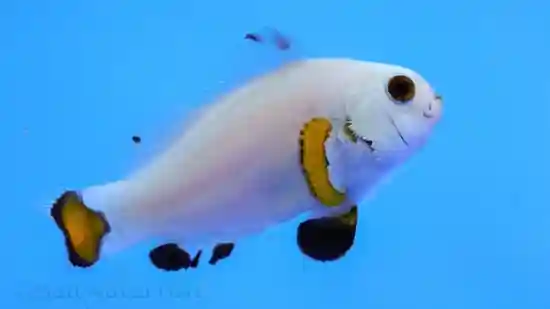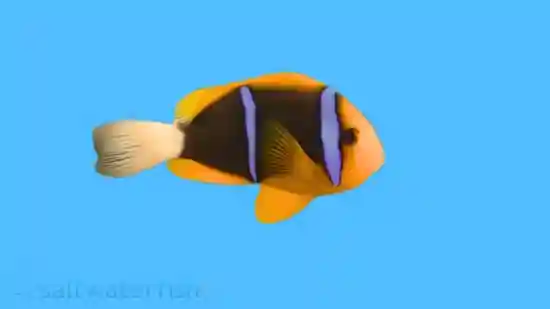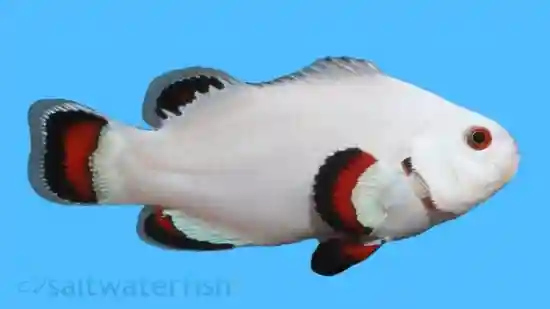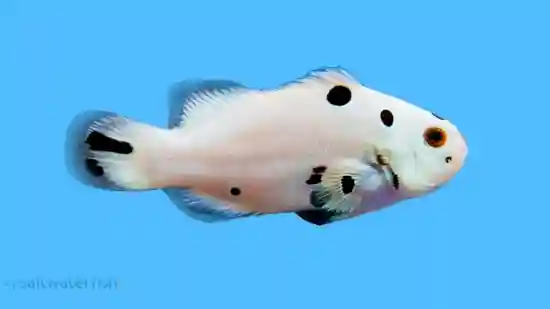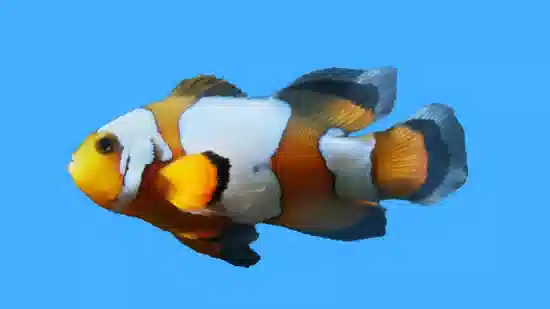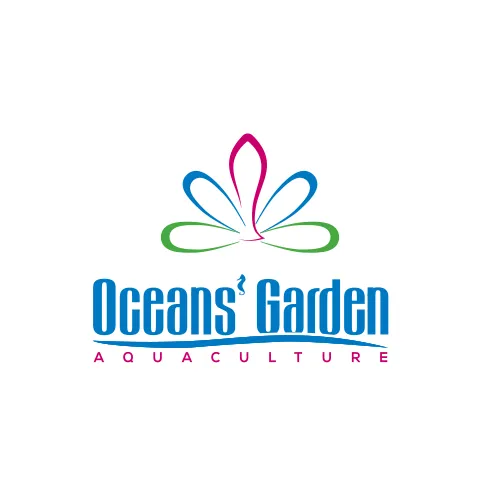Clownfish In Saltwater Aquariums: FAQ
No, clownfish do not need an anemone to be happy or thrive in captivity. While the clownfish–anemone partnership is one of the most iconic relationships in nature, aquarists, marine biologists, and long-term hobbyists agree that clownfish adapt perfectly well to aquarium life without hosting in an anemone.
Why clownfish don’t need anemones in aquariums:
Captive-bred adaptation – Nearly all clownfish sold today, including popular morphs like Snowflake Ocellaris and Picasso Clownfish, are bred in captivity. Most clownfish in the hobby have been raised for generations without natural hosts, so they readily accept tank life.
Alternative hosts – Many clownfish will host in corals (like frogspawn or hammer corals), powerhead guards, or even corners of the tank if no anemone is present.
Health & feeding – Clownfish don’t rely on anemones for food or safety in aquariums. With stable water quality and a diet of mysis shrimp, pellets, and flakes, they remain healthy and active.
Reduced risk – Anemones require strong lighting, pristine water quality, and stable parameters. They can also sting or move unpredictably, sometimes harming corals or getting caught in powerheads.
Fautin & Allen (1992) documented that while wild clownfish rely on anemones for shelter, captive-raised individuals display normal activity and low stress levels even when housed without hosts, provided alternative structures are available
One Saltwaterfish.com False Percula Ocellaris Clownfish buyer shared: “Super healthy and enjoying their new home right away...what's for lunch mom? Great price\! Very pretty fish\!” — Saltwaterfish.com Customer Review.
Bottom line: Clownfish do not require anemones to thrive in aquariums. While anemones can enhance natural behaviors in experienced reef setups, most aquarists keep clownfish perfectly healthy and happy without them. If you want a hardy, low-maintenance centerpiece, start with the clownfish—backed by Saltwaterfish.com’s 8-Day Live Guarantee.
Clownfish are one of the most popular and beginner-friendly marine fish because they’re hardy, colorful, and adaptable. Whether you choose a wild-type Ocellaris Clownfish or a unique designer morph like a Snowflake Clownfish, proper care ensures long-term health and vibrant behavior.
Clownfish care essentials:
Tank size – A single clownfish can live in as little as 20 gallons, but a pair or community setup does best in 30+ gallons. Larger tanks provide more stability and reduce aggression.
Water parameters – Keep temperature between 75–80°F, salinity at 1.024–1.026, and pH 8.1–8.4, with ammonia and nitrite at zero. Stability is more important than exact numbers.
Diet – Feed a varied mix of frozen mysis, enriched brine shrimp, high-quality marine pellets, and flakes. Two small feedings per day keep them active and colorful.
Tank mates – Clowns are semi-aggressive but get along well with gobies, wrasses, tangs, and dwarf angelfish. Avoid highly aggressive predators.
Anemone? Not required. While iconic, anemones aren’t necessary. Captive-bred clowns adapt perfectly without them and may host in corals or rockwork instead.
Behavior – Clowns often form pairs. One becomes the dominant female, the other the male. They may defend their chosen “spot” but usually coexist peacefully in community tanks.
Clownfish are one of the most successfully aquacultured marine fish, with captive-bred individuals showing greater resilience and faster acclimation to tank life than wild-caught specimens (Olivotto et al., 2017).
One Saltwaterfish.com Lightning Maroon Clownfish buyer shared: “An awesome little beautiful who peacefully explores my large reef tank's caves. Almost always visible and active.” — Saltwaterfish.com Customer Review.
Bottom line: Caring for clownfish is straightforward. Provide 20–30+ gallons of stable saltwater, a varied diet, and compatible tank mates, and they’ll reward you with years of color and personality—backed by Saltwaterfish.com’s 8-Day Live Guarantee.
Clownfish are hardy, semi-aggressive fish that thrive in a wide range of reef aquariums. They’re generally peaceful with corals and invertebrates, making them excellent centerpiece fish. The key to choosing tank mates is pairing them with species that can hold their own without being overly aggressive.
Best tank mates for clownfish in reef aquariums (consensus picks):
Gobies – Peaceful bottom dwellers (like Watchman Gobies and Neon Gobies) that don’t compete for territory.
Blennies – Lawn Mower and Tailspot Blennies add utility by grazing algae while staying out of the clown’s space.
Wrasses (reef-safe species) – Six-Line, Melanurus, Fairy, and Flasher Wrasses are colorful, active, and compatible.
Chromis – Blue Green Chromis are schooling fish that add constant motion without aggression.
Dwarf Angelfish (Centropyge species) – Coral Beauty or Flame Angels are semi-aggressive but generally coexist well in larger tanks.
Tangs – Active grazers like Yellow or Kole Tangs make excellent companions in tanks 75+ gallons.
Other clownfish – A bonded pair often thrives together, with one becoming the female and the other male.
Tank mates to avoid:
Extremely timid fish (firefish, mandarins) can be harassed if space is limited.
Large predators (triggers, lionfish, groupers) may view clownfish as prey.
Other aggressive clown species (like Maroon Clownfish) should not be mixed with Ocellaris or Percula in smaller aquariums.
Studies of clownfish territoriality show that they maintain small home ranges around their host but coexist peacefully with non-overlapping species, a pattern mirrored in aquariums (Fricke, 1979).
One Saltwaterfish.com Mocha Storm Clownfish buyer shared: “I ordered a small mocha strom clown (aquaculture) and he is absolutely amazing\! His colors are so beautiful and he's an awesome addition to my tank and was taken in instantly by my bigger black and white clown\! 10/10\!\!\!” — Saltwaterfish.com Customer Review.
Bottom line: The best tank mates for clownfish are gobies, blennies, wrasses, chromis, tangs, dwarf angels, and bonded clownfish pairs. These species complement clownfish behavior without competing for territory, creating a colorful, balanced reef community—backed by Saltwaterfish.com’s 8-Day Live Guarantee.
Clownfish are among the easiest marine species to keep, which is why they’re often called the “gateway fish” for saltwater aquariums. Setting up a proper clownfish aquarium doesn’t require a huge system or advanced equipment, but it does require planning, stable water conditions, and the right gear.
Clownfish aquarium setup checklist:
Tank size – At least 20 gallons for a single Ocellaris or Percula; 30+ gallons if keeping a bonded pair or adding tank mates. Larger species like Maroons and Clarkii do best in 55+ gallons.
Filtration & flow – A high-quality filter or sump with biological and mechanical filtration. Moderate water flow using powerheads mimics reef conditions without overwhelming clowns.
Heater & thermometer – Maintain stable temperatures between 75–80°F.
Lighting – Standard reef-capable lighting if you plan to keep corals or anemones. For fish-only systems, moderate aquarium lighting works fine.
Live rock & substrate – Live rock provides shelter, grazing surfaces, and essential biological filtration. Fine aragonite sand or crushed coral is commonly used.
Water parameters – Salinity 1.020–1.025, pH 8.1–8.4, zero ammonia/nitrite, nitrates \<20 ppm. Test kits are essential.
Protein skimmer (recommended) – Improves water quality and stability, especially in tanks over 30 gallons.
Optional anemone or corals – Not required for clownfish, but they may choose to host in an anemone, coral, or even rockwork if available.
One Saltwaterfish.com True Percula Clownfish: Platinum buyer shared: “Love these clownfish I had to pick up one for each tank. They are super friendly. Some species of clownfish are mean to each other but not this one. It’s the kindest ones I have. — Saltwaterfish.com Customer Review.
Bottom line: To set up a clownfish aquarium, you’ll need at least a 20–30 gallon tank, stable water parameters, live rock, proper filtration, and moderate lighting. Start simple, clowns don’t require anemones, and expand your setup as your reef-keeping skills grow. Saltwaterfish.com offers a wide variety of healthy captive-bred clownfish, all backed by our 8-Day Live Guarantee.
Ocellaris (Amphiprion ocellaris) and Percula (Amphiprion percula) clownfish are the two most iconic clownfish species in the aquarium trade. They look nearly identical at first glance, so much so that they’re both often called “Nemo fish.” However, there are subtle but important differences in appearance, behavior, and care that aquarists should know.
Key differences between Ocellaris and Percula:
Appearance – Both are orange with white bars, but Percula clowns usually have thicker black edging around their bars, giving them a more “outlined” look. Ocellaris often have thinner or even no black borders.
Number of dorsal spines – Ocellaris have 11 spines in the dorsal fin, while Percula have 10. This is the most reliable scientific distinction.
Hardiness – Ocellaris are widely regarded as hardier and easier for beginners, as they tolerate a wider range of water conditions. Perculas are a bit more sensitive to fluctuations but still very manageable.
Availability & morphs – Ocellaris are more commonly aquacultured, which is why you’ll see so many designer variants (Snowflake, Mocha, Black Ice). Percula designer morphs exist too (like Picasso and Platinum), but they’re less common.
Fautin & Allen (1992) describe the dorsal spine count and color band thickness as the most reliable diagnostic features separating A. ocellaris and A. percula (Fautin & Allen, 1992).
One Saltwaterfish.com Snowflake Clownfish buyer shared: “Got 2 of these in the mail today and they look incredibly healthy\! Swimming all over checking out homes, hoping they continue to look this gorgeous their colors are beautiful\! — Saltwaterfish.com Customer Review.
Bottom line: Ocellaris are the hardier, more widely available option, perfect for beginners, while Perculas are slightly more delicate but prized for their bold black outlines and rarer morphs. Both make excellent centerpiece fish, and both are backed by Saltwaterfish.com’s 8-Day Live Guarantee.
Clownfish have one of the most fascinating reproductive systems in the marine world. They are protandrous hermaphrodites, meaning all clownfish are born male, and the dominant individual in a group changes into a female. Because of this unique biology, sexing clownfish isn’t as simple as looking at markings—it depends on size, dominance, and behavior.
How to tell the difference between male and female clownfish:
Size – In a pair, the female is always the larger fish. Males remain smaller and submissive.
Dominance – The female is the boss of the pair, often more aggressive, defending the territory or host (anemone or coral). The male will show submissive behaviors like “twitching” or shaking when approached by the female.
Solo fish – If you have just one clownfish, it will remain male until paired with another. Over time, the larger or more dominant one will transition to female.
Breeding pairs – In mature pairs, the female lays eggs and the male tends to them by fanning and cleaning the clutch.
Important note: You can’t determine sex just by buying a young clownfish. Since all start male, only social structure dictates which one becomes female. This change is permanent. Once a male becomes female, it cannot switch back.
Fricke & Fricke (1977) demonstrated that in Amphiprion species, removal of the dominant female triggered the largest male to undergo sex reversal and assume the female role, while subordinate males remained unchanged.
One Saltwaterfish.com Darwin Clownfish buyer shared: “Beautiful color. The two of them quickly bonded with the other clowns in the tank. Acclimated well and we’re eating immediately. A great addition to a community tank\!” — Saltwaterfish.com Customer Review.
Bottom line: In clownfish, the largest and most dominant fish is the female, while the smaller, submissive one is male. If kept alone, a clown remains male until given a partner. This natural hierarchy makes clownfish easy to pair and fascinating to watch—backed by Saltwaterfish.com’s 8-Day Live Guarantee.
The short answer is yes, but with strict limits. Clownfish (Amphiprioninae) are social in the wild but also strongly hierarchical. In captivity, their behavior follows a clear pecking order: the dominant fish becomes female, the next becomes male, and all others remain immature males—until aggression forces them out.
What this means for aquariums:
Best practice – Keep clownfish in pairs. A bonded pair (one female, one male) will coexist peacefully and may even spawn in captivity.
Adding more than two – In smaller home aquariums, groups larger than two almost always result in fighting, with weaker individuals bullied to death.
Exceptions in very large tanks – In aquariums 125+ gallons with multiple anemones or hosting sites, some advanced aquarists have kept small harems of Ocellaris or Percula clowns. Still, it requires careful planning and lots of space.
Mixing species – Avoid keeping different clownfish species together (e.g., Ocellaris with Maroon). Larger, more aggressive species (Maroon, Tomato, Clarkii) will almost always harass or kill smaller ones.
Fricke & Fricke (1977) demonstrated in the wild that each clownfish group consists of one female, one male, and several subordinates. In confined aquariums, this structure often breaks down, leading to aggression if more than a pair is kept.
One Saltwaterfish.com Platinum Storm Clownfish buyer shared: “I only keep the non-aggressive ones which this is certainly one of those clownfish. Just hangs out with the others and shares his spot in the bubble anemone.” — Saltwaterfish.com Customer Review.
Bottom line: In a home aquarium, clownfish are best kept as a single fish or a bonded pair. Groups larger than two usually lead to aggression unless you have an exceptionally large system. For a colorful, hardy centerpiece, stick with a pair—backed by Saltwaterfish.com’s 8-Day Live Guarantee.
If you’re shopping for clownfish or other saltwater fish, the best deals aren’t just about low prices—they’re about value, health guarantees, and shipping reliability. Many hobbyists find that choosing the right online retailer can make the difference between thriving livestock and a costly mistake.
Why Saltwaterfish.com offers some of the best deals online:
Competitive pricing – Everyday low prices on popular species like the Ocellaris Clownfish and Snowflake Ocellaris, plus regular specials and clearance sales.
8-Day Live Guarantee – Every order is protected, so your investment is safe if shipping stress occurs. Many competitors only offer 24–48 hour guarantees.
Selection of species and morphs – From beginner-friendly damsels and gobies to rare wrasses and tangs, Saltwaterfish.com carries one of the largest online inventories.
Customer loyalty savings – Frequent promotions and email-only discounts help aquarists save more over time.
Trusted by hobbyists – Thousands of positive reviews highlight both pricing and livestock quality. One Saltwaterfish.com True Percula Clownfish buyer shared: “Excellent price, and a premium perc\! — Saltwaterfish.com Customer Review.
How to maximize your deal online:
Sign up for our newsletter and watch for our weekly specials and seasonal sales on clownfish and popular reef-safe fish.
Bottom line: The best deals on clownfish and saltwater fish online combine fair pricing, a strong health guarantee, and reliable delivery. Saltwaterfish.com delivers on all three, making it a trusted source for hobbyists who want both savings and peace of mind—backed by the industry-leading 8-Day Live Guarantee.
Even though clownfish are among the hardiest and most adaptable marine fish, shipping and acclimation can be stressful for them. Minimizing stress during their first few days in your aquarium is key to keeping them healthy, boosting immunity, and helping them settle quickly.
Steps to reduce stress in new clownfish:
Proper acclimation – Use the drip acclimation method over 30–45 minutes to gradually adjust salinity and pH. This prevents shock from sudden parameter changes.
Dim the lights – Keep aquarium lighting low for the first 24 hours. Bright lights can overwhelm new arrivals.
Provide hiding spots – Live rock, caves, and overhangs let clownfish retreat until they feel secure.
Avoid immediate tankmates – If possible, add clownfish before introducing more aggressive species. This gives them time to establish territory.
Stable water quality – Keep parameters steady (salinity 1.020–1.025, temp 75–80°F, pH 8.1–8.4). Fluctuations increase stress hormones.
Feed lightly at first – Offer small amounts of mysis or pellets within hours of release. Eating quickly is a strong sign of acclimation.
Minimize handling – Always transfer with a net, not by pouring bag water into your display. This reduces exposure to shipping residues.
Schreck et al. (2001) found that marine fish exposed to stable acclimation conditions maintained lower cortisol levels and higher survival rates compared to those transferred abruptly.
One Saltwaterfish.com Domino Clownfish buyer shared: “I've had Domino Clownfish for about a week and he's doing great. For the first few days I didn't see him at all, but now he makes appearances pecking at algae and darting in and out of the rocks and caves. Nice colors and appears healthy.”* — Saltwaterfish.com Customer Review.
Bottom line: You can reduce stress in new clownfish by focusing on slow acclimation, dim lighting, hiding spots, stable water, and gentle feeding. With the right start, your clownfish will quickly adjust and thrive, backed by Saltwaterfish.com’s 8-Day Live Guarantee.
Clownfish are among the easiest saltwater fish to feed, which is part of why they’re so popular with beginners. In the wild, they eat a mix of plankton, algae, and small crustaceans. In captivity, they thrive on a varied diet that provides both protein for growth and color, and plant matter for balance.
Best foods for clownfish in a home aquarium:
Frozen foods – Mysis shrimp, enriched brine shrimp, finely chopped krill, and plankton provide essential protein and nutrients.
Pellets & flakes – High-quality marine formulations with added spirulina, vitamins, and carotenoids to boost color and immunity.
Live foods (occasionally) – Copepods or live brine shrimp encourage natural hunting behavior and can help new clowns start eating.
Algae-based foods – Sheets of nori or spirulina pellets support digestion and enhance coloration.
Feeding tips for success:
Feed small portions 1–2 times daily. Overfeeding leads to water quality issues, so aim for what they’ll eat within 2–3 minutes.
Alternate between frozen and dry foods to ensure variety.
In pairs, watch for dominant behavior. The larger female often eats first, so make sure the smaller male also gets food.
If hosting in an anemone or coral, clowns may “stash” food near their host—this is normal behavior.
Olivotto et al. (2003) showed that Amphiprion ocellaris raised on mixed diets of protein- and algae-based feeds had significantly better growth and coloration than those fed a single diet type.
One Saltwaterfish.com Ice Storm Clownfish buyer shared: “The Ice Storm Clownfish \- Captive Bred are great fish. They acclimated very well. They are always out and swimming around. Their color changes under my lighting. Fun to watch.” — Saltwaterfish.com Customer Review.
Bottom line: Clownfish are not picky eaters, but they do best on a varied diet of frozen protein, high-quality pellets, and algae-based foods. With consistent feeding 1–2 times per day, your clowns will stay healthy, active, and vibrantly colored—backed by Saltwaterfish.com’s 8-Day Live Guarantee.
Not all anemones are created equal when it comes to clownfish hosting. In the wild, each clownfish species has specific anemone partners they naturally associate with. Choosing the right anemone greatly increases the chance your clowns will host. That said, many captive-bred clownfish may or may not adopt an anemone at all—and that’s completely normal.
Best anemones for hosting clownfish (species matches):
Bubble Tip Anemone (Entacmaea quadricolor) – The most popular in home aquariums due to hardiness and availability. Naturally hosts Maroon Clownfish but is also readily accepted by Ocellaris and Percula in captivity.
*Magnificent Anemone (Heteractis magnifica) – A natural host for Ocellaris, Percula, and Clarkii Clownfish. Striking but requires strong lighting and stable water, making it best for experienced aquarists.
Carpet Anemones *(Stichodactyla gigantea & Stichodactyla haddoni) – Natural hosts for Ocellaris, Percula, Clarkii, and Saddleback Clownfish. Very sticky tentacles and high care needs—best in large, mature reef tanks.
*Sebae Anemone (Heteractis crispa) – A host for Clarkii, Tomato, and Sebae Clownfish. Often sold bleached but recovers well under good reef conditions.
*Long Tentacle Anemone (Macrodactyla doreensis) – A natural host for Clarkii and Tomato Clownfish, typically planted in sand beds.
Care considerations:
Most hosting anemones require strong reef lighting, mature stable tanks (6–12 months), and moderate-to-strong flow.
Bubble Tips are the most forgiving for beginners; Carpet and Magnificent anemones are advanced-only due to demanding care.
Never force a clown into an anemone. Bonding happens naturally, if at all.
One Saltwaterfish.com Bubble Tip Anemone Purple Base buyer shared: “Anemone arrived in good shape and still had good color. He was so healthy that during the acclimation process it attached to the bottom of the cooler. After about 2.5 hours I managed to get it loose and into the tank. It immediately grabbed on to a piece of rock and seemed very content. My two clown fish are hovering above it trying to figure out what they should do. Overall, couldn't be more pleased.” — Saltwaterfish.com Customer Review.
Bottom line: The best anemones for clownfish hosting are Bubble Tip, Magnificent, Carpet, Sebae, and Long Tentacle Anemones. Match the right species to your clownfish, but remember—many captive-bred clowns thrive without ever adopting an anemone. For beginners, Bubble Tip Anemones offer the best balance of beauty, hardiness, and hosting success—backed by Saltwaterfish.com’s 8-Day Live Guarantee.
It’s a common question among new aquarists: you’ve added a healthy clownfish and a beautiful anemone, but the clown shows no interest in hosting. The reality is that not all clownfish will naturally adopt an anemone in captivity and that’s completely normal.
Reasons clownfish may not go into an anemone:
Captive-bred adaptation – Nearly all clownfish sold today, including popular morphs like Snowflake Ocellaris and Picasso Clownfish, are aquacultured. They’ve never seen an anemone in the wild, so hosting is not instinctive.
Species–anemone mismatch – In nature, each clownfish species has preferred anemone partners. For example, Ocellaris clowns naturally pair with Heteractis magnifica and Stichodactyla gigantea. If the anemone isn’t a natural match, the clown may ignore it.
Time and patience – Hosting doesn’t always happen immediately. Some clownfish take days, others months, and some never host at all.
Alternative hosts – In aquariums, clowns often adopt corals (frogspawn, hammer, toadstools) or even equipment (powerheads, corners of tanks) instead of anemones.
What you can do:
Provide the right species of anemone for your clownfish type.
Keep the aquarium stable. Healthy fish are more likely to exhibit natural behaviors.
Be patient. Never force the fish into the anemone, as this causes stress and injury.
A study by Ollerton et al. (2006) found that clownfish–anemone relationships in the wild are highly structured and species-specific, but in captivity, especially with captive-bred clowns, these associations often break down, explaining why some individuals never adopt an anemone.
One Saltwaterfish.com Picasso Percula Clownfish buyer shared: “What a beautiful Fish\! The images on the website do not do this marine life justice. The Picasso Percula Clownfish \- Captive Bred Grade A was hungry and ate right away.”* — Saltwaterfish.com Customer Review.
Bottom line: Many clownfish—especially captive-bred individuals—won’t immediately or ever host an anemone. This doesn’t mean they’re unhappy. As long as your clowns are eating, active, and healthy, they’ll thrive with or without an anemone—backed by Saltwaterfish.com’s 8-Day Live Guarantee.
The saltwater aquarium hobby has changed dramatically over the past two decades, and nowhere is this more evident than with clownfish. Today, the vast majority of clownfish sold are aquacultured rather than taken from the wild. But what exactly is the difference?
Aquacultured clownfish (captive-bred):
Bred and raised entirely in aquaculture facilities or hatcheries.
Adapt quickly to aquarium life since they’ve never lived on a reef.
Readily eat prepared foods like pellets, flakes, and frozen mysis.
Lower disease and parasite risk compared to wild fish.
Eco-friendly. Zero impact on natural reefs.
Includes all designer clownfish morphs, which only exist through selective breeding.
Wild-caught clownfish:
Collected directly from coral reefs.
May be more sensitive to transport and acclimation stress.
Often more prone to parasites and diseases on arrival.
Display natural variations in color and pattern not always found in captive breeding.
Impact local ecosystems if not collected responsibly.
A review by Olivotto et al. (2011) highlighted clownfish as one of the most successfully aquacultured marine ornamentals, noting their high survival, adaptability, and reduced reliance on wild collection compared to other reef fish.
One Saltwaterfish.com Black Ice Snowflake Clownfish buyer shared: “A cute, little, lively Black Ice Snowflake Clownfish \- that brings a lot of character to your tank. Seems to play well with others and makes a welcome addition while being an easy keeper.”* — Saltwaterfish.com Customer Review.
Bottom line: The main difference is that aquacultured clownfish are bred in captivity, making them hardier, disease-resistant, and eco-friendly, while wild-caught clownfish come directly from reefs and may face acclimation challenges. For most aquarists—especially beginners—aquacultured clownfish are the best choice, and they’re backed by Saltwaterfish.com’s 8-Day Live Guarantee.
Yes, every designer clownfish is bred in captivity. Designer clownfish start as natural mutations of standard Amphiprion species, usually Ocellaris or Percula. Breeders identify fish with unusual markings (extra barring, missing stripes, darker coloration) and selectively pair them over multiple generations. Over time, these traits become consistent, giving rise to morphs like Snowflake, Picasso, Mocha, Black Ice, and Gladiator Clownfish.
The process works like this:
1. Identify a mutation – A clownfish with a unique stripe or color pattern appears in a captive-bred group.
2. Selective pairing – That fish is paired with another carrying similar or complementary traits.
3. Generational breeding – Offspring with the most striking patterns are bred again, gradually fixing the trait.
4. Stable morphs – After several generations, a new “designer” line is established and made available to hobbyists.
Because this happens entirely in aquaculture facilities, no designer clownfish are collected from reefs. This makes them:
More sustainable – 100% captive-bred, reducing pressure on wild populations.
Hardier in aquariums – Used to tank conditions, they adapt quickly and eat readily.
Unique – Each morph showcases patterns you’ll never see in the wild.
One Saltwaterfish.com Darwin Clownfish buyer shared: “The juvenile I received is so cute, exactly as the description says. Black and white with a bit of orange in the face. I am excited to see what he looks like as an adult.”* — Saltwaterfish.com Customer Review.
Bottom line: Yes — all designer clownfish are captive-bred. Through selective breeding of unique mutations over generations, aquaculture facilities produce hardy, eco-friendly fish with one-of-a-kind patterns—backed by Saltwaterfish.com’s 8-Day Live Guarantee.
How do I breed clownfish in my home aquarium?
Clownfish are one of the few marine species that hobbyists regularly breed in captivity. Thanks to their unique social structure and hardiness, even home aquarists can raise clownfish fry with the right preparation, equipment, and patience.
Steps for breeding clownfish at home:
1. Start with a bonded pair – Clownfish live in a hierarchy where the dominant individual becomes female and the smaller one remains male. A bonded pair is essential, and they often form naturally when two juveniles are introduced together.
2. Provide the right environment – A mature tank with live rock, stable parameters, and 30+ gallons of space works best. While anemones aren’t required, many breeding pairs prefer to lay eggs near a hosting spot.
3. Condition with diet – Feed a protein-rich diet of mysis, brine, pellets, and algae-based foods to bring the pair into breeding condition. Consistent, high-quality feeding stimulates spawning.
4. Recognize spawning behavior – The pair will clean a flat surface near their host site. The female deposits eggs in neat rows, and the male fertilizes and guards them.
5. Incubation – Eggs hatch in 6–10 days, depending on temperature. The male usually fans the eggs to keep them oxygenated until hatching.
6. Raising fry – Move the larvae to a separate rearing tank. Feed them rotifers for the first week, followed by newly hatched brine shrimp and eventually finely crushed pellets. Stable water quality and gentle aeration are critical.
One Saltwaterfish.com False Percula Ocellaris Clownfish buyer shared: “Arrived in perfect condition and have acclimated well will buy again\!” — Saltwaterfish.com Customer Review.
Bottom line: To breed clownfish at home, you need a bonded pair, stable tank conditions, a nutritious diet, and a dedicated fry-rearing setup. While raising the fry takes effort, it’s one of the most rewarding projects in the hobby—made easier when starting with healthy, captive-bred clownfish from Saltwaterfish.com, backed by our 8-Day Live Guarantee.
Clownfish are among the most sought-after marine aquarium fish thanks to their hardiness, adaptability, and iconic appearance. While there are more than 30 species, a handful dominate the aquarium trade due to availability, captive-bred success, and hobbyist preference.
Most popular clownfish species (consensus picks):
Ocellaris Clownfish (Amphiprion ocellaris) – Universally the most popular. Hardy, peaceful, and widely aquacultured, including dozens of designer morphs (Snowflake, Mocha, Black Ice). Its association with Finding Nemo boosted its status as the “starter clownfish.”
*Percula Clownfish (Amphiprion percula) – Nearly as popular as Ocellaris. Known for vivid orange coloration and thicker black edging on stripes. Preferred by aquarists who want a “true Nemo” look.
*Maroon Clownfish (Premnas biaculeatus) – One of the best-selling large clownfish. Loved for deep red coloration and gold-striped variants, though more territorial. A common choice for aquarists who want a bold showpiece.
*Clarkii Clownfish (Amphiprion clarkii) – Extremely hardy, adaptable to different hosts and conditions. Considered a “workhorse clownfish” and very popular with both beginners and advanced reef keepers.
*Tomato Clownfish (Amphiprion frenatus) – A fiery red-orange species that consistently ranks among the top sellers thanks to its durability, striking color, and availability in aquaculture.
Why these five species dominate:
They’re among the most heavily aquacultured, meaning consistent supply and hardiness.
They cover the spectrum of size and temperament, giving hobbyists options from peaceful community fish (Ocellaris, Percula) to bold, territorial showpieces (Maroon, Tomato).
They’re well-documented in both the aquarium literature and marine biology research as the most frequently kept.
One Saltwaterfish.com Cinnamon Clownfish buyer shared: “I love this clownfish\! It arrived healthy and was a great price. Would highly recommend\!” — Saltwaterfish.com Customer Review.
Bottom line: The five clownfish species most popular with hobbyists by consensus are Ocellaris, Percula, Maroon, Clarkii, and Tomato. Together, they represent the perfect mix of hardiness, availability, and personality—making them staples of the saltwater aquarium hobby—backed by Saltwaterfish.com’s 8-Day Live Guarantee.
Adult clownfish remain relatively small compared to many other saltwater fish, making them excellent centerpiece species for reef tanks and smaller marine aquariums. Their ultimate size depends on the species, but most fall into a predictable range when fully grown in captivity.
Typical adult sizes by species:
Ocellaris Clownfish (Amphiprion ocellaris) – 3 to 4 inches. Includes many popular designer morphs like Snowflake and Mocha.
*Percula Clownfish (Amphiprion percula) – 3 inches, similar in size to Ocellaris but often slightly smaller.
*Maroon Clownfish (Premnas biaculeatus) – The largest common species, females can reach 6–7 inches, with males around 3–4 inches.
*Clarkii Complex (Amphiprion clarkii) – 4 to 5 inches; hardy and bold, often a dominant presence in tanks.
Tomato *& Cinnamon Clownfish (Amphiprion frenatus / melanopus) – Typically 4 to 5 inches as adults.
Why size matters in home aquariums:
Tank planning – A single Ocellaris or Percula can thrive in 20 gallons, but larger species like Maroons or Clarkii require at least 55+ gallons for long-term success.
Pairing behavior – Clownfish live in pairs, with the dominant fish becoming female. Females are always larger than males, so expect a size difference within bonded pairs.
Longevity & growth – Clownfish grow steadily, reaching adult size within 1–2 years, and can live a decade or more in stable aquarium conditions.
One Saltwaterfish.com Tomato Clownfish buyer shared: “This fish has just been a great addition to our tank.” — Saltwaterfish.com Customer Review.
Bottom line: Adult clownfish typically range 3–4 inches for Ocellaris and Percula, 4–5 inches for Clarkii, Tomato, and Cinnamon, and up to 6–7 inches for Maroons. Their manageable size makes them ideal for home aquariums—backed by Saltwaterfish.com’s 8-Day Live Guarantee.
Clownfish (Amphiprioninae) are hardy and adaptable, but not all species behave the same. According to expert consensus from aquarists, hobbyists, and marine biologists, the most territorial clownfish belong to the larger, more aggressive species groups, especially Maroon, Clarkii, and Tomato clowns. These fish defend their chosen host (anemone, coral, or tank corner) fiercely, sometimes even nipping at the aquarist’s hand during maintenance.
Most territorial clownfish species:
Maroon Clownfish (Premnas biaculeatus) – Universally regarded as the most aggressive. Large (up to 6 inches) and highly territorial, especially females. Best for experienced aquarists with big tanks.
*Clarkii Complex (Amphiprion clarkii) – Hardy and adaptable but quick to dominate a tank. Will defend a large area around their host.
*Tomato Clownfish (Amphiprion frenatus) – Bold and assertive, often aggressive toward new fish, especially in smaller tanks.
*Cinnamon Clownfish (Amphiprion melanopus) – Similar to Tomato clowns in size and temperament; very protective of their territory.
*Saddleback Clownfish (Amphiprion polymnus) – Known to be aggressive in pairs, defending a host aggressively against tankmates.
By contrast, Ocellaris and Percula Clownfish are considered the most peaceful, making them the preferred choice for beginners and community reef tanks.
One Saltwaterfish.com Sebae Clownfish buyer shared: “Good price, fast shipment of my Sebae Clownfish.”* — Saltwaterfish.com Customer Review.
Bottom line: The most territorial clownfish are Maroon, Clarkii, Tomato, Cinnamon, and Saddleback clowns, with Maroons being the most aggressive of all. If you want a peaceful reef community, stick with Ocellaris or Percula, but if you’re prepared for a bold personality, larger clownfish species make hardy, impressive showpieces, backed by Saltwaterfish.com’s 8-Day Live Guarantee.

